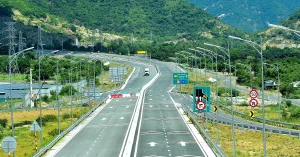Unlocking New Momentum for Vietnamese Logistics: The North–South Expressway Breakthrough
Vietnam’s North–South Expressway (Cao Tốc Bắc–Nam) is emerging as a critical infrastructure game-changer for the country’s logistics sector. Now more than ever, the expressway is creating new opportunities for faster transport, lower costs, and more efficient supply chains — fundamentally shifting how goods move across Vietnam.

Strategic Importance of the North–South Expressway
Deep national connection. The expressway runs through major economic regions, linking the north, central, and south of Vietnam. This continuous highway significantly enhances capacity for road freight, reducing reliance on slower, older transport routes.
-
Boost in trade efficiency. Faster and more reliable transport allows businesses to move goods more rapidly between industrial zones, ports, and consumption centers. This highway becomes a backbone for national and regional logistics.
-
Economic transformation. As transport becomes more efficient, provinces along the expressway corridor are becoming more attractive for logistics hubs, warehouses, and manufacturing investment.
Key Logistic Opportunities Brought by the Expressway
1. Major Cost Reductions
The new expressway is lowering transport costs for freight companies. Because goods can travel faster and more directly, expenses on fuel, labor, and maintenance decrease. This in turn reduces overall logistics costs in regions that previously faced transport barriers.
In some cases, logistics costs are projected to fall by a significant margin, especially for high-volume transport along the north–south corridor.
2. Enhanced Speed and Reliability
Transport times are shrinking markedly, giving companies more predictability in delivery schedules. This boost in reliability also strengthens inventory planning, allowing more efficient supply chain management and less buffer stock.
3. Stronger Multimodal Integration
The expressway opens up possibilities for multimodal logistics by acting as a link between inland hubs, regional ports, and rail terminals. Warehouses and distribution centers can be optimized around expressway exits, enabling smoother road-to-rail or road-to-waterway transfers.
4. Support for “Green” Logistics
Shorter, faster transport routes help reduce carbon emissions. With more efficient road networks and fewer slow, congested segments, logistics companies can cut down on fuel use and emissions — aligning with broader sustainability goals in the transport sector.
Case Study: Logistics Boost in Ha Tinh Province
A prominent example of the expressway’s impact is seen in Ha Tinh province:
-
The portion of the expressway in Ha Tinh, from Vung Ang to Bùng, recently opened — eliminating a historical bottleneck.
-
As a result, the time for goods to move by road has dropped significantly, helping lower transport costs and improve reliability.
-
Local exporters, especially those in agricultural and seafood sectors, benefit from faster access to larger markets and more cost-effective routes.
-
The investment is also attracting more logistics infrastructure: warehousing, distribution centers, and industrial parks are increasingly viable near the expressway.
This case highlights how improved infrastructure can reshape the logistics and economic landscape of a region.
Challenges and Risks to Consider
While the expressway brings many benefits, several challenges remain:
-
Maintenance and tolls: High-speed highways require regular upkeep, and toll costs may affect profitability for freight operators.
-
Infrastructure around exits: To fully leverage expressway benefits, regions need investment in supporting logistics infrastructure (warehouses, loading zones, last-mile links).
-
Traffic management: With increased freight traffic, managing congestion, especially at entry/exit points, will be essential.
-
Sustainable planning: Ensuring logistics development along the expressway aligns with environmental goals and sustainable growth is key to long-term success.
What Businesses Should Do Now
-
Logistics companies: Reassess routing strategies to take advantage of expressway speed gains. Consider shifting to more road-based transport or multimodal routes.
-
Manufacturers and exporters: Use new expressway access to optimize your supply chain. Establish or expand logistics hubs or cross-docking facilities along the corridor.
-
Investors and developers: Explore opportunities for warehouses, distribution centers, and logistics real estate near expressway interchanges.
-
Sustainability advocates: Push for eco-friendly practices by promoting fuel-efficient fleets, green warehouses, and low-emission operations along the expressway.
Conclusion
The completion and expansion of the North–South Expressway in Vietnam represent more than just a highway project — it is a transformative lever for the country’s logistics and economic future. By reducing costs, speeding transport, and enabling modern logistics infrastructure, the expressway offers a “once-in-generation” opportunity for businesses to scale, optimize, and innovate.
Read more:
Hoa Kỳ Chính Thức Miễn Thuế Đối Với Nhiều Loại Nông Sản – Cơ Hội Mở Rộng Cho Doanh Nghiệp Việt Nam
Dịch vụ mua hộ sách từ Ấn Độ về Việt Nam giá rẻ

